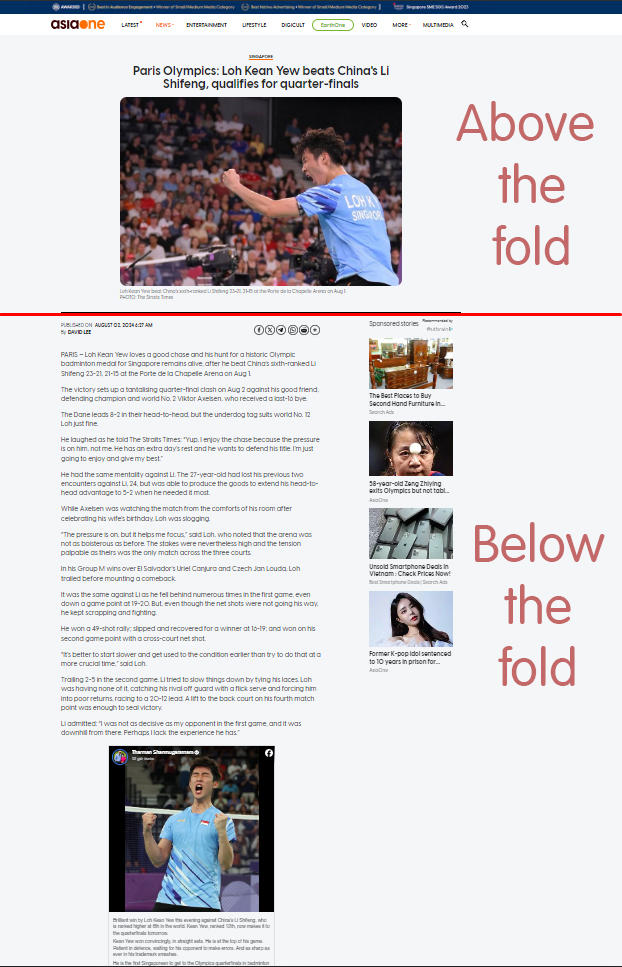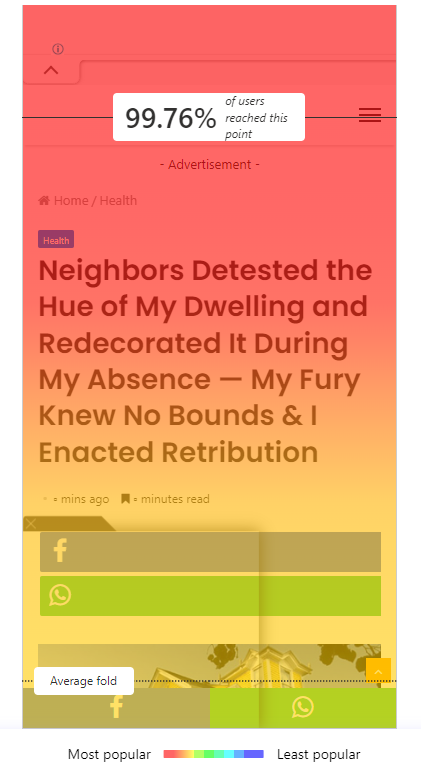Understanding where to place your ads can make or break your revenue strategy. If you’re a publisher wondering whether “above the fold” (ATF) or “below the fold” (BTF) placement will maximize your earnings, you’re asking the right question.
The numbers tell a compelling story: ATF video ads achieve 73% viewability, while BTF ads only reach 45% viewability. But before you rush to cram all your ads above the fold, there’s more to consider. This guide breaks down everything you need to know about ATF and BTF ad placement.
Contents
What Are ATF and BTF in Digital Advertising?
Above the Fold (ATF) Definition
Above the fold refers to the portion of your webpage that visitors see immediately when your page loads—without any scrolling required. This prime digital real estate gets instant attention from every visitor.
The term originated from newspaper publishing, where the most important headlines were placed on the top half of the front page, visible even when newspapers were folded and displayed on newsstands.
Below the Fold (BTF) Definition
Below the fold describes all content that requires scrolling to become visible. While this might sound like a disadvantage, BTF content and ads can still drive significant engagement when used strategically.
Why Screen Size Matters More Than Ever
Unlike newspapers with fixed dimensions, websites face an endless variety of screen sizes. What appears “above the fold” on a desktop monitor might be “below the fold” on a mobile device. This reality makes modern fold optimization more complex—and more important—than ever.

ATF Ad Placement: Advantages and Challenges
The Power of Immediate Visibility
Guaranteed Impressions: Every visitor sees ATF ads, ensuring maximum exposure for your ad inventory. This immediate visibility translates directly to higher CPM rates and more advertiser demand.
Higher Click-Through Rates: ATF ads naturally attract more clicks because they’re the first thing users encounter. This increased engagement makes ATF inventory particularly valuable for time-sensitive campaigns and premium advertisers.
Premium Pricing: Advertisers pay significantly more for ATF placements because of their proven performance. Publishers using platforms like PubPower can leverage header bidding to maximize competition for these premium spots.

The Challenges You Need to Know
Ad Blindness: Users have become accustomed to seeing ads in predictable ATF locations. Some visitors unconsciously ignore these spaces, a phenomenon known as “banner blindness.“
User Experience Balance: Cramming too many ads above the fold can harm user experience and hurt your SEO rankings. Google’s algorithms favor sites that balance monetization with user value.
Limited Space: ATF real estate is finite. You need to carefully choose which ads deserve this premium placement versus other important content elements.
BTF Ad Placement: Hidden Opportunities
The Underestimated Value of BTF
Reduced User Disruption: BTF ads don’t interfere with your primary content consumption, leading to better user experience and potentially higher engagement rates when users do scroll.
Cost-Effective Inventory: BTF placements cost less to serve but can still generate meaningful revenue, especially on content-rich pages where users spend significant time scrolling.
Contextual Relevance: BTF ads can be strategically placed within relevant content sections, increasing their contextual value and performance.

Strategic BTF Implementation
Smart publishers don’t dismiss BTF inventory—they optimize it:
Sticky Elements: BTF sticky ads can follow users as they scroll, combining BTF placement with ATF-like visibility
Native Ad Integration: BTF ads work exceptionally well when designed as native content recommendations
Lazy Loading: Modern ad servers can lazy-load BTF ads, improving page speed while maintaining revenue opportunities
Device-Specific Strategies for ATF and BTF
Mobile Optimization
Mobile devices have fundamentally changed the fold equation:
- Smaller Screens: Less ATF space means more selective ad placement
- Thumb-Friendly Zones: Consider placement within natural mobile interaction areas
- Progressive Enhancement: Use responsive design to optimize ad placement across screen sizes
Desktop Considerations
Desktop environments offer more ATF space but different user behaviors:
- Wider Layouts: More horizontal space for multiple ad units
- Peripheral Vision: Users can process more simultaneous information
- Mouse Tracking: Heat map data shows different engagement patterns than mobile
Modern Solutions: How Header Bidding Changes Everything
Maximizing Both ATF and BTF Revenue
Traditional ad serving often leaves money on the table. Header bidding platforms like PubPower enable you to:
Unified Auction Pressure: Every ad placement—ATF or BTF—benefits from real-time competition among 30+ Supply-Side Platforms (SSPs)
Dynamic Pricing: Floor prices adjust automatically based on placement performance, ensuring inventory commands optimal rates
Comprehensive Reporting: Real-time analytics show exactly how each placement performs, enabling data-driven optimization decisions
Advanced BTF Optimization Tools
Modern ad tech makes BTF inventory more valuable than ever:
A/B Testing: Compare different ATF/BTF configurations to find your optimal setup
AdBlock Recovery: Tools like PubPower’s AdBlock Detector can recover 40% of lost revenue from both ATF and BTF placements
Lazy Loading: Improves page speed while ensuring BTF ads load when needed
Frequently Asked Questions
Q: Is ATF always better than BTF for ad revenue?
While ATF generally generates higher CPMs and viewability rates, BTF can still be profitable when implemented strategically. The key is understanding your audience behavior and optimizing both placements rather than focusing exclusively on ATF.
Q: How do I know if my ATF/BTF balance is optimal?
Monitor key metrics like overall RPM, user engagement (bounce rate, time on page), and viewability rates. Use A/B testing to compare different configurations and let data guide your decisions rather than assumptions.
Q: Does Google penalize sites with too many ATF ads?
Google’s guidelines discourage excessive ATF advertising that pushes content below the fold. Focus on balancing user experience with monetization—typically 1-2 premium ATF ad units work best.
Q: How has mobile usage changed ATF/BTF strategies?
Mobile screens have less ATF space, making placement decisions more critical. Mobile users also scroll more readily than desktop users, making well-placed BTF ads more valuable on mobile than traditional desktop environments.
Q: What’s the future of fold-based advertising?
While the basic concept remains relevant, fold-based strategies are evolving toward more dynamic, personalized approaches. AI-driven platforms increasingly optimize placement based on individual user behavior rather than static fold positions.
Conclusion: Your Next Steps
The ATF vs BTF debate isn’t about choosing one over the other—it’s about optimizing both strategically. With ATF ads achieving 73% viewability compared to BTF’s 45%, ATF clearly deserves premium focus, but smart publishers also maximize their BTF potential.
Ready to optimize your ATF and BTF strategy? Modern header bidding platforms like PubPower make it easier than ever to maximize revenue from both placements while maintaining excellent user experience. With transparent reporting, 30+ SSP integration, and advanced optimization tools, you can stop guessing and start earning based on real performance data.
The future belongs to publishers who master both ATF and BTF monetization. Which placement will you optimize first? Contact us for more information: https://pubpower.io/contact-us/



